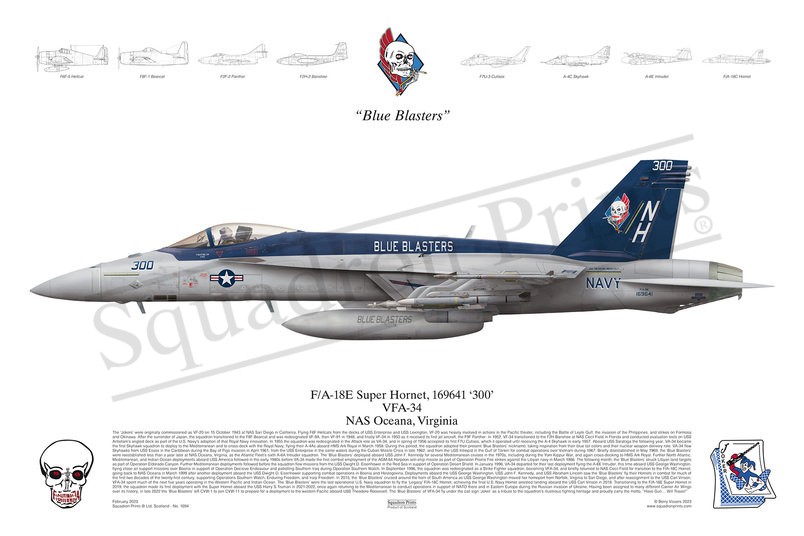#1694 VFA-34 F/A-18E Super Hornet print

Description
Squadron Prints Lithograph No. 1694 - 169641 '300', F/A-18E Super Hornet, VFA-34, NAS Oceana, Virginia.
The ‘Jokers’ were originally commissioned as VF-20 on 15 October 1943 at NAS San Diego in California. Flying F6F Hellcats from the decks of USS Enterprise and USS Lexington, VF-20 was heavily involved in actions in the Pacific theater, including the Battle of Leyte Gulf, the invasion of the Philippines, and strikes on Formosa and Okinawa. After the surrender of Japan, the squadron transitioned to the F8F Bearcat and was redesignated VF-9A, then VF-91 in 1948, and finally VF-34 in 1950 as it received its first jet aircraft, the F9F Panther. In 1952, VF-34 transitioned to the F2H Banshee at NAS Cecil Field in Florida and conducted evaluation tests on USS Antietam’s angled deck as part of the U.S. Navy’s adoption of that Royal Navy innovation. In 1955 the squadron was redesignated in the Attack role as VA-34, and in spring of 1956 accepted its first F7U Cutlass, which it operated until receiving the A-4 Skyhawk in early 1957. Aboard USS Saratoga the following year, VA-34 became the first Skyhawk squadron to deploy to the Mediterranean and to cross-deck with the Royal Navy, flying their A-4As aboard HMS Ark Royal in March 1958. During this period, the squadron adopted their present ‘Blue Blasters’ nickname, taking inspiration from their blue tail colors and their nuclear weapon delivery role. VA-34 flew Skyhawks from USS Essex in the Caribbean during the Bay of Pigs invasion in April 1961, from the USS Enterprise in the same waters during the Cuban Missile Crisis in late 1962, and from the USS Intrepid in the Gulf of Tonkin for combat operations over Vietnam during 1967. Briefly disestablished in May 1969, the ‘Blue Blasters’ were reestablished less than a year later at NAS Oceana, Virginia, as the Atlantic Fleet’s sixth A-6A Intruder squadron. The ‘Blue Blasters’ deployed aboard USS John F. Kennedy for several Mediterranean cruises in the 1970s, including during the Yom Kippur War, and again cross-decking to HMS Ark Royal. Further North Atlantic, Mediterranean, and Indian Ocean deployments aboard USS America followed in the early 1980s before VA-34 made the first combat employment of the AGM-84 Harpoon anti-ship missile as part of Operation Prairie Fire strikes against the Libyan navy in March 1986. The following month, the ‘Blue Blasters’ struck Libyan land targets as part of Operation Eldorado Canyon. Further Mediterranean deployments followed before the squadron flew missions from the USS Dwight D. Eisenhower in the Red Sea in support of Operation Desert Shield. In January 1996, VA-34 departed for their last deployment flying the A-6E Intruder, this time aboard USS George Washington, flying close air support missions over Bosnia in support of Operation Decisive Endeavour and patrolling Southern Iraq during Operation Southern Watch. In September 1996, the squadron was redesignated as a Strike Fighter squadron, becoming VFA-34, and briefly returned to NAS Cecil Field for transition to the F/A-18C Hornet, going back to NAS Oceana in March 1999 after another deployment aboard the USS Dwight D. Eisenhower supporting combat operations in Bosnia and Herzegovina. Deployments aboard the USS George Washington, USS John F. Kennedy, and USS Abraham Lincoln saw the ‘Blue Blasters’ fly their Hornets in combat for much of the first two decades of the twenty-first century, supporting Operations Southern Watch, Enduring Freedom, and Iraqi Freedom. In 2015, the ‘Blue Blasters’ cruised around the horn of South America as USS George Washington moved her homeport from Norfolk, Virginia to San Diego, and after reassignment to the USS Carl Vinson, VFA-34 spent much of the next five years operating in the Western Pacific and Indian Ocean. The ‘Blue Blasters’ were the last operational U.S. Navy squadron to fly the ‘Legacy’ F/A-18C Hornet, achieving the final U.S. Navy Hornet arrested landing aboard the USS Carl Vinson in 2018. Transitioning to the F/A-18E Super Hornet in 2019, the squadron made its first deployment with the Super Hornet aboard the USS Harry S Truman in 2021-2022, once again returning to the Mediterranean to conduct operations in support of NATO there and in Eastern Europe during the Russian invasion of Ukraine. Having been assigned to many different Carrier Air Wings over its history, in late 2022 the ‘Blue Blasters’ left CVW-1 to join CVW-11 to prepare for a deployment to the western Pacific aboard USS Theodore Roosevelt. The ‘Blue Blasters’ of VFA-34 fly under the call sign ‘Joker’ as a tribute to the squadron’s illustrious fighting heritage and proudly carry the motto, “Have Gun… Will Travel!”
